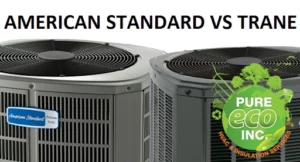In a world where energy efficiency and sustainable living are becoming increasingly important, one easy solution stands out for cooling homes and keeping them comfortable while reducing energy consumption: radiant barrier installation. By harnessing the power of reflective technology, radiant barriers offer an innovative approach to help you insulate your house, reduce heat flow, and minimize heat transfer. This article explores radiant barrier installation and uncovers the best installation methods. If you require a more comprehensive consultation even after reading this information, please don’t hesitate to contact us for a free consultation.
METHODS TO INSTALL A RADIANT BARRIER
PLACE THEM AGAINST THE RAFTERS
A radiant barrier is a foil insulation that works as a reflective insulation. You can place it directly against the bottom side of your rafters, just below the roof line on the wood. This method is generally best in hot climates like L.A. in order to get the highest possible energy savings per year.
INSTALL THEM OVER THE ATTIC INSULATION
You can also install the foil over insulation that is already inside your attic ceiling, between the roof rafters. This method is usually used in colder climates because it maximizes the heat retention of the attic space while helping during the colder months as well, even in places like Southern California.
Alternatively, you can place one radiant barrier above your attic ceiling insulation and a second one below to maximize the beneficial effects in both summer and winter.
Whichever approach you choose, don’t allow any dust to accumulate on top of the reflective surface during the installation. That is why our radiant barrier insulation service includes air-sealing the barrier to make a complete envelope where no air can get in.

How to Install a Radiant Barrier
Before installing radiant barrier insulation in your attic, adequately prepare the space and gather the necessary tools and materials. Also, create a secure working environment by ensuring safety measures are in place. This way, you can ensure a smooth and secure installation process for your radiant barrier. This section guides you through the pre-installation steps.
1. Assess the Attic Space
Start by assessing your attic space to determine its condition and suitability for radiant barrier installation. Look for any signs of moisture, leaks, or damage that may need to be addressed before proceeding. Ensure that the attic is properly ventilated to prevent the buildup of heat and moisture.
Measure the dimensions of your attic to determine the amount of radiant barrier foil and material you will need. Consider any unique features or obstacles in the attic, such as vents, chimneys, or electrical wiring, as these may require special attention during installation.
2. Gather the Necessary Tools and Materials
You will need the following tools and materials, depending on your preferred barrier foil insulation method:
- Radiant barrier material: Choose the appropriate type of radiant barrier for your needs, such as reflective foil or foil-faced insulation boards. Ensure that you have enough material to cover the entire attic space.
- Utility knife or scissors: These will be used to cut the radiant barrier material to the desired size.
- Measuring tape or ruler: Accurate measurements are crucial for properly sizing and cutting the radiant barrier material.
- Ladder: A sturdy ladder is necessary for accessing the attic safely.
- Safety equipment: Wear protective clothing, such as long sleeves, gloves, and safety goggles, to shield yourself from potential hazards.
- Flashlight: A flashlight will help illuminate the attic, especially in areas with limited lighting.
- Staple gun and staples (for stapling method—see below): If you opt for the stapling method of installation, a staple gun will be required to secure the radiant barrier in place.
- Adhesive or spray applicator (for spray-on method—see below): If you choose the spray-on radiant barrier method, you will need an appropriate adhesive or spray applicator to apply the barrier.
3. Ensure Your Safety
Working in an attic can present various safety risks, so take the necessary precautions. First of all, ensure that the attic is well-lit to improve visibility and reduce the risk of accidents. Use a portable light source or install additional lighting if necessary.
You will also need proper ventilation. Attics can become hot and stuffy, so open windows or use fans to promote air circulation while working.
Another common problem is that attics are often cluttered, which makes it easy to trip. Make sure the attic floor is sturdy and free from debris and clear any obstructions that may cause tripping or slipping hazards. If the attic has an open or unfinished space, use a safety harness or other fall protection equipment to prevent accidents.
Also, be cautious of electrical wiring. Avoid contact with live wires and ensure that power sources are turned off when necessary.
Finally, wear appropriate protective gear, such as gloves, goggles, and a dust mask, to safeguard against potential hazards like insulation fibers or airborne particles.
RADIANT BARRIER INSTALLATION METHODS
When it comes to radiant barrier installation, there are several methods available, each tailored to suit different types of structures and budgets. The three main ones are stapling, foil-faced insulation board, and spray-on.
Method 1: The Stapling Method for Radiant Barrier Installation
The stapling attic radiant barrier installation method is a popular and straightforward approach. It involves securing the radiant barrier material to the underside of the roof rafters using a staple gun and provides an efficient and cost-effective way to enhance the energy efficiency of your home.
To successfully install a radiant barrier using the stapling method, you will first need to clear the attic space. Next, measure and cut the radiant barrier and install the first row, stapling the foil in place. Overlap and secure subsequent rows until you have covered the entire roof, making sure to address any obstacles such as ductwork.
Tips and Best Practices for the Stapling Method
To make the process more efficient, consider using a helper. One person can hold the radiant barrier in place while the other operates the staple gun.
Also, before you staple the foil, ensure that the staple gun is compatible with the thickness of the radiant barrier material. Test a few staples on a scrap piece before starting the installation to avoid jamming or incomplete penetration.
While stapling the radiant barrier, avoid compressing or flattening the insulation. Only by maintaining the recommended R-value of the existing insulation can you maximize energy efficiency.
Be especially cautious when working around electrical wiring, ductwork, or other potential hazards in the attic. If in doubt, consult a professional electrician to ensure safety.
Finally, inspect the installed radiant barrier regularly for any signs of sagging, damage, or gaps. Address any issues promptly to maintain the barrier’s effectiveness.
Method 2: Foil-Faced Insulation Board Method
The foil-faced insulation board method is another effective approach to installing a radiant barrier in your attic. It involves using rigid insulation boards with a reflective foil facing to create a barrier against radiant heat and provides a durable and effective solution to reduce radiant heat transfer.
To successfully install a radiant barrier using the foil-faced insulation board method, start with clearing the attic space. Next, measure and cut the insulation boards. Secure the boards, one at a time, and seal the joints.
During installation, you may encounter obstacles such as vents, chimneys, or electrical wiring in the attic. Cut the insulation boards to accommodate these, leaving enough space for proper airflow and functionality. Use foil tape or specialized insulation sealants to seal any gaps or seams around these areas while maintaining the integrity of the radiant barrier.
Tips and Best Practices for the Foil-Faced Insulation Board Method
Safety always comes first, so wear protective gloves and safety goggles when handling insulation boards to prevent any potential skin irritation or eye injury.
It can be hard to keep the insulation boards horizontal and maintain a consistent alignment. To help, use a straightedge or level. Also, use a foam board adhesive in addition to the fasteners to provide extra stability and prevent any movement or shifting of the insulation boards.
In addition, insulate any exposed edges or corners of the insulation boards using foam insulation strips or spray foam to prevent heat transfer and maintain the efficiency of the radiant barrier.
Finally, inspect the foil-faced insulation boards regularly for any signs of damage or deterioration and replace any damaged boards promptly to ensure the optimal performance of the radiant barrier.
Method 3: Spray-On Radiant Barrier Method
The spray-on radiant barrier method offers a convenient and versatile approach to installing a radiant barrier in your attic. It involves applying a liquid radiant barrier directly onto the underside of the roof decking or other surfaces using a spray applicator and offers flexibility and ease of application.
The first step to installing a radiant barrier using the spray-on method is to clear the attic space and prepare the area for spraying. When everything is ready, apply the spray-on radiant barrier, making sure to cover every nook and cranny and to avoid any obstacles such as ductwork. Finally, allow plenty of time for drying and curing.
Tips and Best Practices for Spray-On Radiant Barrier Method
Wear appropriate protective gear, including gloves, goggles, and a respiratory mask when applying the spray-on radiant barrier, and follow all safety guidelines provided by the manufacturer.
Using a high-quality spray applicator that provides consistent and controlled spray patterns for even coverage will be immensely helpful, if you have access to one. Test it first by applying a small dose of the radiant barrier product onto a small, inconspicuous area before starting the full application. This will help ensure compatibility and desired results.
If needed, apply multiple coats to achieve the desired thickness and performance—just allow sufficient drying time between coats as directed by the manufacturer.
Finally, inspect the spray-on radiant barrier regularly for any signs of damage or wear and address any issues promptly to maintain the barrier’s effectiveness.
Post Radiant Barrier Installation Considerations
Once you have successfully installed a radiant barrier in your attic, conduct post-installation inspections, perform regular maintenance, and address any repairs or issues that may arise. By staying proactive in the care of your insulation, you can ensure its long-term effectiveness and maximize its energy-saving benefits.
Inspecting the Installed Radiant Barrier
Regular inspections of the installed radiant barrier are essential to assess its condition and identify any potential problems.
Start by checking for any signs of damage, such as tears, punctures, or loose sections in the radiant barrier material. Ensure that it is properly secured and that there are no gaps or areas where the barrier has come loose.
Next, verify that the radiant barrier is aligned properly and covers the intended areas completely. Ensure that there are no areas where the barrier has shifted, leaving gaps or exposed surfaces.
Pay special attention to areas where the radiant barrier intersects with obstacles or penetrations, such as vents, chimneys, or electrical wiring. Ensure that the barrier is properly sealed around these and that there are no gaps or openings that could compromise its effectiveness.
Finally, check for any signs of moisture buildup or mold growth on or around the radiant barrier. Moisture can affect the barrier’s performance and lead to other issues, so address any sources of moisture and ensure proper ventilation in the attic space.
Maintaining and Repairing the Radiant Barrier
A well-maintained and functioning radiant barrier contributes to improved comfort, energy efficiency, and cost savings in the long run. By conducting regular inspections, performing necessary maintenance, and addressing any repairs or issues promptly, you can ensure that your radiant barrier continues to provide optimal energy-saving benefits for your home.
Consider the following practices for best results.
- Cleaning: Remove any dust, dirt, or debris that may accumulate on the surface of the radiant barrier. Use a soft brush or vacuum with a brush attachment to gently clean it and avoid any harsh chemicals or abrasive materials that could damage it.
- Sealing and Patching: If you identify any damaged or compromised areas in the radiant barrier, such as tears or punctures, promptly address them by sealing or patching them. Use foil tape or specialized radiant barrier repair products recommended by the manufacturer to ensure a proper and effective repair.
- Insulation Integrity: Ensure that the existing insulation in the attic remains in good condition and is not compressed or displaced by the radiant barrier installation. Inspect the insulation regularly and address any issues that may arise, such as settling or damage, to maintain its insulating properties.
- Moisture Management: Pay attention to the attic’s ventilation and moisture management systems. Ensure proper airflow and ventilation to prevent excess moisture buildup, which can affect the performance of the radiant barrier. Address any issues with roof leaks or condensation promptly to maintain a dry and healthy attic environment.
- Periodic Inspections: Schedule regular inspections of the radiant barrier to assess its condition and address any maintenance or repair needs. Conduct these annually or as recommended by the manufacturer or a professional.
COMMON MYTHS AND ASSUMPTIONS
There are some false assumptions concerning radiant barrier systems and how effective they are. A lot of people fear, for example, that they are so energy-efficient that they will cause excessive heat build-up in their attic.
The foil will keep your home and attic a little warmer during the winter, but it certainly won’t create an overheating problem. In fact, it keeps your attic cooler at the time of year when that’s desirable.
Others fear that their aluminum surface will corrode over time and lose its effectiveness. Tests have conclusively refuted this, as aluminum foil does not rust.
A third myth is that a radiant barrier can “cook” roofing shingles. But any heat absorbed by shingles will only raise their temperature by a few degrees. Every shingle can handle temperatures of 160 to 190 degrees Fahrenheit, so adding 5 degrees to that is hardly going to “cook” them.
Another myth is that a radiant barrier can reduce your cellular phone signal. Phone signals pass through the attic floor, walls, window glass, and more, and won’t be blocked by a thin layer of paper and aluminum.
Finally, some people think that radiant barriers can only be installed in new homes. In fact, three-quarters of the homes we put them into were built during the 20th Century.
Trust Pure Eco Inc for Your Radiant Barrier
When it comes to radiant barriers, there is no best installation method that fits all homes. The right method to install an attic radiant barrier on your house depends on your needs and specific circumstances. Contact us today for further info and to get a free estimate for any insulation service you may need. When you call us, we will check your specifics and give you a no-obligation consultation and an accurate estimate. Find out why our customers love our efficient solutions and trust us with their radiant barrier installation!







